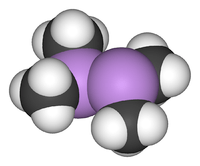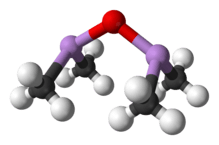Cadet's fuming liquid
Cadet's fuming liquid was a red-brown oily liquid prepared in 1760 by the French chemist Louis Claude Cadet de Gassicourt (1731-1799) by the reaction of potassium acetate with arsenic trioxide.[1] It consisted mostly of dicacodyl (((CH3)2As)2) and cacodyl oxide (((CH3)2As)2O). The reaction for forming the oxide was something like:
- 4 KCH3COO + As2O3 → ((CH3)2As)2O + 2 K2CO3 + 2 CO2


These were the first organometallic substances prepared, so Cadet can be regarded as the father of organometallic chemistry.[2]
The liquid develops white fumes when exposed to air, resulting in a pale flame producing carbon dioxide, water, and arsenic trioxide. It has a nauseating, very disagreeable, garlic-like odor.
Around 1840, Robert Bunsen did much work on characterizing the compounds in the liquid and derivatives of them. This was important in the development of chemistry (see Radical theory).
References
- Seyferth, D. (2001). "Cadet's Fuming Arsenical Liquid and the Cacodyl Compounds of Bunsen". Organometallics. 20 (8): 1488–1498. doi:10.1021/om0101947.
- Jaouen, G. (2006). Bioorganometallics: Biomolecules, Labeling, Medicine. Wiley. ISBN 3-527-30990-X.